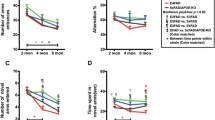Abstract
Apolipoprotein-E-deficient mice provide a useful model system for studying the role of apolipoprotein E (apoE) in brain function. In the present study, we characterization the cholinergic function of these mice and the extent of phosphorylation of their cytoskeletal protein τ. Morris water maze tasks revealed deficits in working memory that were accompanied by a specific decrease in hippocampal and cortical choline acetyltransferase activities. Immunoblot experiments utilizing native and dephosphorylated τ and antibodies directed against specific phosphorylated and unphosphorylated τ epitopes revealed that τ of the apoE-deficient mice is hyperphosphorylated. These results show that apoE-deficient mice have cognitive cholinergic and cytoskeletal derangements and point out the importance of this model for studying the role of apoE in neuronal function.
Similar content being viewed by others
References
Binder L. I., Frankfurter A., and Ribhum L. I. (1985) The distribution of tau in the mammalian central nervous system.J. Cell. Biol. 101, 1371–1378.
Buresova O., Bolhuis J. J., and Bures J. (1986) Differential effects of cholinergic blockade on performance of rats in the water tank navigation task and in radial water maze.Behav. Neurosci. 100, 476–482.
Goedert M., Jakes R., Crowther R. A., Cohen P., Vanmechelen E., Vandermerven M., and Cas P. (1994) Epitope mapping of monoclonal antibodies to the paired helical filaments of Alzheimer's disease: Identification of phosphorylation sites in tau protein.Biochem. J. 301, 871–877.
Grauer E. and Kapon J. (1993) Wistar-Kyoto rats in the Morris swim maze: impaired working memory and hyperactivity to stress.Behav. Brain Res. 59, 147–151.
Masliah E., Mallory M., Alford M., and Mucker L. (1994) Abnormal synaptic regeneration in hAPP transgenic and apoE knockout mice.Neurobiol. Aging 15 S, 46.
Masliah E., Mallory M., Alford M., Ge N., and Mucke L. (1995) Abnormal synaptic regeneration in hAPP695 transgenic and apoE knockout mice, inResearch Advances in Alzheimer's Disease and Related Disorders (Iqbal K., Mortimer J. A., Winblad B., and Wisniewski H. M., eds.), John Wiley, Chichester, pp. 405–414.
Mawal-Dewan M., Henley J., Van de Voorde A., Trojanowski J. Q., and Lee V. M.-Y. (1994) The phosphorylation state of tau in the developing rat brain is regulated by phosphoprotein phosphatase.J. Biol. Chem. 269, 30,981–30,987.
Morishima-Kawashima M., Hasegawa M., Takio K., Suzuki M., Yoshida H., Titani K., and Ihava Y. (1995) Proline directed and non-proline directed phosphorylation of PHF-tau.J. Biol. Chem. 270, 823–829.
Morris R. (1984) Development of a water-maze procedure for studying spatial learning in the rat.J. Neurosci. Methods 11, 47–60.
Namba Y., Tomanaga M., Kawasaki H., Otomi E., and Ikada K. (1991) Apolipoprotein E immunoreactivity in cerebral amyloid deposits and neurofibrillary tangles in Alzheimer's disease and Kuru plaque amyloid in Creutzfeld-Jacob disease.Brain Res. 541, 163–166.
Olton D. S. (1986) Hippocampal function and memory for temporal context, inThe Hippocampus, vol. 4 (Isaacson, R. L. and Pribram, K. H., eds.), Plenum, New York, pp. 281–298.
Plump A. S., Smith J. D., Hayek T., Aalto-Setala K., Walsh A., Verstuyff J. G., Rubin E. M., and Breslow J. L. (1992) Severe hypercholesterolemia and atherosclerosis in apolipoprotein E-deficient mice created by homologous recombination in ES cells.Cell 16, 343–353.
Poirier J. (1994) Apolipoprotein E in animal models of CNS injury and in Alzheimer's disease.Trends Neurosci. 17, 525–530.
Roses A. D. (1994) Apolipoprotein E affects the rate of Alzheimer's disease expression: β-amyloid burden is a secondary consequence dependent on ApoE genotype and duration of disease.J. Neuropathol. Exp. Neurol. 53, 429–437.
Selkoe D. S. (1994) Alzheimer's disease: A central role for amyloid.J. Neuropathol. Exp. Neurol. 53, 438–447.
Wisniewski T. and Frangione B. (1992) Apolipoprotein E: A pathological chaperon protein in patients with cerebral and systemic amyloid.Neurosci. Lett. 135, 235–238.
Author information
Authors and Affiliations
Rights and permissions
About this article
Cite this article
Gordon, I., Genis, I., Grauer, E. et al. Biochemical and cognitive studies of apolipoprotein-E-deficient mice. Molecular and Chemical Neuropathology 28, 97–103 (1996). https://doi.org/10.1007/BF02815210
Received:
Accepted:
Published:
Issue Date:
DOI: https://doi.org/10.1007/BF02815210




